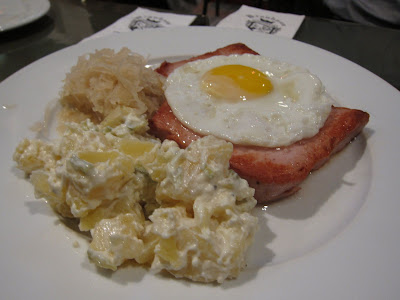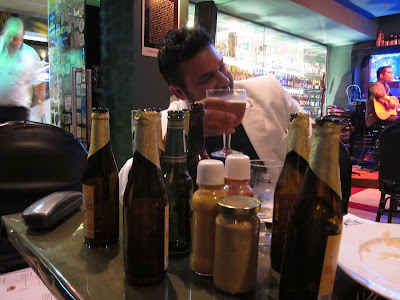Eating the World in Singapore
 Having tasted Malay, Chinese and Japanese food during the preceding days, I turned to Turkish and German for the remaining day! Completely different cuisines from different parts of the world but prepared and served by immigrants from those countries in Singapore. While both Turkish and German cuisine is dominated by breads and meat, they are - of course - completely different.
Having tasted Malay, Chinese and Japanese food during the preceding days, I turned to Turkish and German for the remaining day! Completely different cuisines from different parts of the world but prepared and served by immigrants from those countries in Singapore. While both Turkish and German cuisine is dominated by breads and meat, they are - of course - completely different.
Lamb (or mutton) dominates Turkish cuisine, usually served minced or in the form of kebap which can be grilled, baked or slow cooked in a pot.

I picked a dish of lamb shank braised in vegetables, while others chose the Yogurtlu Kebap, made of mutton koftas served on toasted pita bread with tomato, yogurt, and garlic sauce. My lamb was richly flavored and very tender and the others seemed to enjoy their Kebap too.


We ended with a rich dessert called Kunefe or Slice of Heaven. Made of layers of shredded pastry joined by a thin slice of unsalted cheese, baked in a hot oven, and topped with light syrup and pistachios and a drizzle of cream, this was one exquisite dessert!

In the evening, we dined at a German Brauhaus that boasted hundred of beers from around the world and a large selection of German sausages.

For anyone familiar with Germans, bread is probably their most significant food followed by potatoes with pork being their most favoured meat. I never lose a chance to buy myself a sausage roll whenever I pass through Munich airport. Their breads and sausages even within airport shops seem far superior to those you find commonly in the USA.

The variety of sausages in Germany can be over-whelming: Wurst in the north tends to be made from raw meat, while in the south varieties made of finely minced meat are enhanced with larger pieces of ham or pickled tongue and scalded. Wurstchen are smaller and served heated and whole, often in pairs, while Leberwurst, liver sausages, is spreadable resembling chopped liver.

The other ubiquitous vegetable in German cuisine is cabbage. Cabbage raw and in form of salads are present as a side along with the meat dishes.
The sausage platters with six different varieties of German sausages, cabbage and potato salads had to be frequently replenished as the beer bottles piled up on our table. I stayed with the excellent Belgian La Poluchette until it was time to head back.

This Brauhaus had some really exotic selections of beer from far corners of the world: from Austria and Bolivia to Ghana and Equador.


1 comment:
Hi Shantanu,
Can you please name the Turkish and German restaurants you went to? Can't wait to go!
Thanks.
Vinayak
Post a Comment